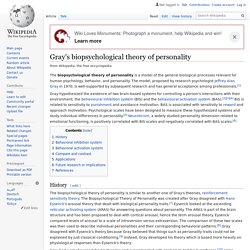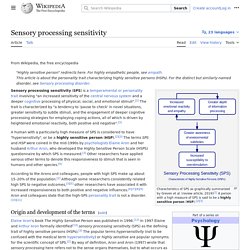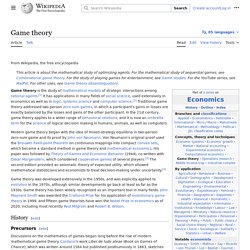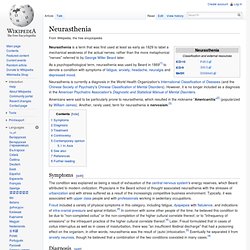

Gray's biopsychological theory of personality. The biopsychological theory of personality is a model of the general biological processes relevant for human psychology, behavior, and personality.

The model, proposed by research psychologist Jeffrey Alan Gray in 1970, is well-supported by subsequent research and has general acceptance among professionals.[1] Cognitive reframing. Cognitive reframing is a psychological technique that consists of identifying and then changing the way situations, experiences, events, ideas, and/or emotions are viewed.[1] Cognitive reframing is the process by which such situations or thoughts are challenged and then changed.

In the context of cognitive therapy, cognitive reframing is referred to as cognitive restructuring. Sensory processing sensitivity. Characteristics of SPS as graphically summarized by Greven et al.

(review article, 2019)[1] A person with a high measure of SPS is said to be a highly sensitive person (HSP).[2][3] Sensory processing sensitivity (SPS) is a temperamental or personality trait involving "an increased sensitivity of the central nervous system and a deeper cognitive processing of physical, social and emotional stimuli".[2] The trait is characterized by "a tendency to 'pause to check' in novel situations, greater sensitivity to subtle stimuli, and the engagement of deeper cognitive processing strategies for employing coping actions, all of which is driven by heightened emotional reactivity, both positive and negative".[3] Origin and development of the terms[edit] In 2015, sociologist Elizabeth Bernstein wrote in The Wall Street Journal that HSPs were "having a moment," noting that several hundred research studies had been conducted on topics related to HSPs' high sensitivity.
Thomas Szasz. Hungarian psychiatrist Thomas Stephen Szasz ( SAHSS; Hungarian: Szász Tamás István [saːs]; 15 April 1920 – 8 September 2012) was a Hungarian-American academic, psychiatrist and psychoanalyst.

He served for most of his career as professor of psychiatry at the State University of New York Upstate Medical University in Syracuse, New York.[4] A distinguished lifetime fellow of the American Psychiatric Association and a life member of the American Psychoanalytic Association, he was best known as a social critic of the moral and scientific foundations of psychiatry, as what he saw as the social control aims of medicine in modern society, as well as scientism. His books The Myth of Mental Illness (1961) and The Manufacture of Madness (1970) set out some of the arguments most associated with him. Szasz maintained throughout his career that he was not anti-psychiatry but was rather anti-coercive psychiatry. Lethargy. See also[edit] References[edit] ^ "Lethargy".

Why 'lawnmower parenting' is like robbing your kids — and how to actually help them. First we had helicopter parents — the types who “hover” over their children’s every move; now, we have lawnmower parents.

Saba Harouni Lurie, a licensed marriage and family therapist defines lawnmower parenting (also referred to as “bulldozing parenting” and “snowplow parenting”) simply as: “when parents remove obstacles for their kids in hopes of setting them up to be successful.” The “Operation Varsity Blues” scandal that recently saw dozens of parents, including recognizable actors Felicity Huffman and Lori Laughlin, charged in a $25 million college cheating scheme, may be interpreted partly as an extreme (and criminal) example of lawnmower parenting; but therapists, parenting coaches and educators say they observe lesser (and legal) variations of lawnmower parenting often. “I see this all the time,” says Jasmine Peters, a parenting life coach and founder of Parenting Wellness Center, LLC. “Most parents don't realize what they are doing until I bring it to their attention.”
Game theory. The study of mathematical models of strategic interaction between rational decision-makers Game theory is the study of mathematical models of strategic interaction among rational decision-makers.[1] It has applications in all fields of social science, as well as in logic, systems science and computer science.

Originally, it addressed zero-sum games, in which each participant's gains or losses are exactly balanced by those of the other participants. In the 21st century, game theory applies to a wide range of behavioral relations, and is now an umbrella term for the science of logical decision making in humans, animals, and computers. Modern game theory began with the idea of mixed-strategy equilibria in two-person zero-sum games and its proof by John von Neumann. Von Neumann's original proof used the Brouwer fixed-point theorem on continuous mappings into compact convex sets, which became a standard method in game theory and mathematical economics. Eric Berne. Eric Berne (May 10, 1910 – July 15, 1970) was a Canadian-born psychiatrist who, in the middle of the 20th century, created the theory of transactional analysis as a way of explaining human behavior.

Berne's theory of transactional analysis was based on the ideas of Freud but was distinctly different. Freudian psychotherapists focused on talk therapy as a way of gaining insight to their patient's personalities. Berne believed that insight could be better discovered by analyzing patients’ social transactions.[1] Berne was the first psychiatrist to apply game theory to the field of psychiatry. Background and education (1927–1938)[edit] Eric Berne was born on May 10, 1910 in Montreal, Quebec, Canada, as Eric Lennard Bernstein. Games People Play (book) Games People Play: The Psychology of Human Relationships is a bestselling 1964 book by psychiatrist Eric Berne.

Since its publication it has sold more than five million copies. The book describes both functional and dysfunctional social interactions. The second half of the book catalogues a series of "mind games" in which people interact through a patterned and predictable series of "transactions" which are superficially plausible (that is, they may appear normal to bystanders or even to the people involved), but which actually conceal motivations, include private significance to the parties involved, and lead to a well-defined predictable outcome, usually counterproductive.
The book uses casual, often humorous phrases such as "See What You Made Me Do," "Why Don't You — Yes But," and "Ain't It Awful" as a way of briefly describing each game. In reality, the "winner" of a mind game is the person that returns to the Adult ego-state first. The most common games are listed below: Neurasthenia. Neurasthenia is a term that was first used at least as early as 1829 to label a mechanical weakness of the actual nerves, rather than the more metaphorical "nerves" referred to by George Miller Beard later.

Neurasthenia is currently a diagnosis in the World Health Organization's International Classification of Diseases (and the Chinese Society of Psychiatry's Chinese Classification of Mental Disorders). However, it is no longer included as a diagnosis in the American Psychiatric Association's Diagnostic and Statistical Manual of Mental Disorders. Americans were said to be particularly prone to neurasthenia, which resulted in the nickname "Americanitis"[2] (popularized by William James). Another, rarely used, term for neurasthenia is nervosism.[3] Symptoms[edit]
Alice Miller (psychologist) In 1953 Miller gained her doctorate in philosophy, psychology and sociology. Between 1953 and 1960, Miller studied psychoanalysis and practiced it between 1960 and 1980 in Zürich. The introduction of Miller's first book, The Drama of the Gifted Child, first published in 1979, contains a line that summarizes her core views: A common phrase many decades ago was “spare the rod and spoil the child”. Covert incest. Covert incest, also known as emotional incest, is a type of abuse in which a parent looks to their child for the emotional support that would be normally provided by another adult.[1] The effects of covert incest on children when they become adults are thought to mimic actual incest, although to a lesser degree.[2] This term describes interactions between a parent and child that are exclusive of sexual abuse.[1] The term has been criticized for broadening the definition of incest to an excessive degree, inflating the prevalence of child abuse,[3][4][5] and being over-used and unsubstantiated.[6] Concept[edit]
Atlas personality. Ulysses pact. A Ulysses pact or Ulysses contract is a freely made decision that is designed and intended to bind oneself in the future. The term is used in medicine, especially in reference to advance directives (also known as living wills), where there is some controversy over whether a decision made by a person in one state of health should be considered binding upon that person when they are in a markedly different, usually worse, state of health.
Origin of the name[edit] Upon hearing the Sirens' song, Ulysses was driven temporarily insane and struggled with all of his might to break free so that he might join the Sirens, which would have meant his death. André Breton. Murder of Kitty Genovese. 1964 murder in New York City, associated with the "bystander effect" In the early hours of March 13, 1964, 28-year-old Kitty Genovese was stabbed outside the apartment building across the street from where she lived, in an apartment above a row of shops on Austin Street, in the Kew Gardens neighborhood of Queens in New York City.[2][3][4] Two weeks after the murder, The New York Times published an article claiming that 38 witnesses saw or heard the attack, and that none of them called the police or came to her aid.[5] The incident prompted inquiries into what became known as the bystander effect or "Genovese syndrome",[6] and the murder became a staple of U.S. psychology textbooks for the next four decades.
However, researchers have since uncovered major inaccuracies in the New York Times article. Police interviews revealed that witnesses either attempted to call the police or were afraid to intervene. Diogenes syndrome. Diogenes syndrome, also known as senile squalor syndrome, is a disorder characterized by extreme self-neglect, domestic squalor, social withdrawal, apathy, compulsive hoarding of garbage or animals, plus lack of shame. Schizoaffective disorder. Schizoaffective disorder (SZA, SZD or SAD) is a mental disorder characterized by abnormal thought processes and an unstable mood.[5][6] The diagnosis is made when the person has symptoms of both schizophrenia (usually psychosis) and a mood disorder—either bipolar disorder or depression—but does not meet the diagnostic criteria for schizophrenia or a mood disorder individually.[5][6] The main criterion for the schizoaffective disorder diagnosis is the presence of psychotic symptoms for at least two weeks without any mood symptoms present.[6] Schizoaffective disorder can often be misdiagnosed[6] when the correct diagnosis may be psychotic depression, psychotic bipolar disorder, schizophreniform disorder or schizophrenia.
Philippe Pinel. Pierre Janet. George Savage (physician) Mind-wandering. William James. William James (January 11, 1842 – August 26, 1910) was an American philosopher and psychologist, and the first educator to offer a psychology course in the United States.[5] James is considered to be a leading thinker of the late nineteenth century, one of the most influential philosophers of the United States, and the "Father of American psychology".[6][7][8] Portia Hypothesis. Liminality. In anthropology, liminality (from the Latin word līmen, meaning "a threshold"[1]) is the quality of ambiguity or disorientation that occurs in the middle stage of rituals, when participants no longer hold their pre-ritual status but have not yet begun the transition to the status they will hold when the ritual is complete. During a ritual's liminal stage, participants "stand at the threshold" between their previous way of structuring their identity, time, or community, and a new way, which the ritual establishes.
Gündüz Vassaf - Vikipedi. Corto maltese sendromu. Exulansis. “Creates beautiful new words that we need but do not yet have.” The Dictionary of Obscure Sorrows. Eugen Bleuler. Synchronicity (The Police album) Bollingen Tower. Justinus Kerner. Toni Wolff. Gaëtan Gatian de Clérambault. Victor Kandinsky. Castration anxiety. Karen Horney. Neo-Freudianism. Neo-Freudianism. William James. Transaksiyonel Analiz Derneği » » Transaksiyonel Analiz Nedir.
Transactional analysis. Games People Play (book) Eric Berne. Sándor Ferenczi. Cognitive behavioral therapy. The Concept of Anxiety. Alexithymia. Ernest Becker. Virginia Satir. Parataxical Integration. Karen Horney - Vikipedi. Self-actualization. Kurt Goldstein. Cyclothymia. Conrad Aiken. ABBE FARIA. Abbé Faria. Erich Fromm. Carl Rogers. James Charles Crumbaugh. Helen Keller. Freud and the Literary Imagination. Psychosomatic medicine. Apophenia. Professor Baruss. Weltschmerz.
Ganser syndrome. Mad to Be Normal. Hanna Segal. Dylan Evans. Yerkes–Dodson law. The genius of apathy and boredom – Karla McLaren. Perseveration. Melanie Klein. Free association (psychology) Max Cavitch's Homepage. Social anxiety disorder. Anxiety disorder. Social anxiety disorder. Liebowitz social anxiety scale. List of diagnostic classification and rating scales used in psychiatry. Disinhibition. Readings in Educational Psychology. Self-efficacy information. Self-Efficacy: The Exercise of Control - Chapter 1.
Albert Bandura. The woman who charmed Nietzsche, Freud and Rilke… Lou Andreas-Salomé. Robert Frager. William James. Egosyntonic and egodystonic. Review of A THEORY OF EVERYTHING. Integral World - About this Website. Integral theory (Ken Wilber) Integral theory (Ken Wilber) Loading site please wait... Fritz Perls. Apathy.